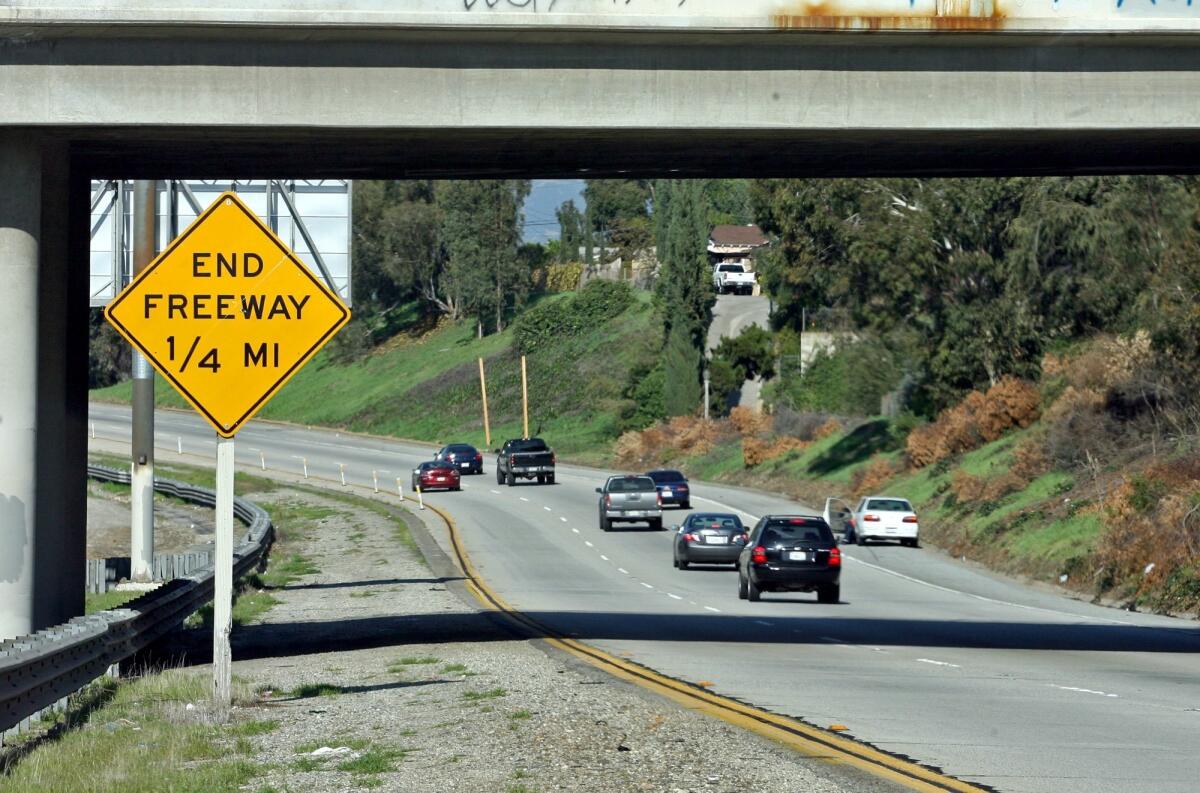MTA’s report on 710 Freeway gap project accused of tunnel vision

This file photo from Thursday, January 28, 2010, shows the terminus of the 710 Freeway at Valley Blvd. in Alhambra.
For months, elected officials and local activists have asked the Metropolitan Transportation Authority for a cost-benefit analysis of five project alternatives being put forth as potential solutions to addressing a 4.5-mile gap in the 710 Freeway between Alhambra and Pasadena.
Now, less than a week after Metro released the long-anticipated document, those who oppose a multibillion-dollar underground tunnel as a means of connecting the freeway’s end points claim the evaluation reveals a pro-tunnel bias and excludes several very real costs.
“It does not instill the confidence in either impartiality or competence I was hoping for,” said former Assemblyman Anthony Portantino, who along with Glendale Mayor Ara Najarian and former La Cañada Flintridge City Councilman Don Voss, among others, urged Metro to issue the document alongside its draft environmental impact report of the alternatives, released on March 6.
Instead, Metro and California Department of Transportation officials issued the cost-benefit analysis Friday, announcing that the deadline by which the public could comment on the DEIR itself would be extended from July 6 to Aug. 5 to accommodate additional input.
The nearly 50-page document attempts to monetize the costs of each alternative, comparing them with a valuation of the benefits each would deliver, in terms of capital expenditures, travel time benefits, emissions, safety effects and job growth associated with the implementation and maintenance of the projects in a 20-year period.
According to the analysis, a 4.2-mile single-bore tunnel, including various toll and truck use scenarios, would cost from $1.95 billion to nearly $2 billion, but could provide nearly $3.6 billion in benefits to the region. It’s dual-bore counterpart, costing up to nearly $3.4 billion, might potentially produce a value of up to $3.73 billion to communities served by the 710 Freeway.
Comparatively, the report states bus infrastructure upgrades would cost $510 million but could add a value of $879 million, while light rail improvements between East Los Angeles and Pasadena would cost up to $2.2 billion, but provide $1.29 billion in estimated benefits.
Among all options, the single-bore tunnel would have the highest net present value — between $1.48 billion and $1.59 billion — according to the report. Reached Wednesday while traveling in Armenia, Najarian stated in a text message his disappointment with the document’s findings.
“To say that the tunnel provides the greatest benefit without stating that it is the most costly, by far, borders on misrepresentation,” Najarian stated, referring to previous tunnel estimates from Metro as high as $5.6 billion. “I will be bringing this dereliction of basic duties owed to the taxpayers of the county to the highest authorities who have jurisdiction over this matter — enough is enough.”
Sharing his reactions to the analysis, Voss said inclusion of the estimated “employment benefits” associated with each option creates potentially misleading discrepancies in their net values. When employment benefits are removed, he stated, a combination of traffic management and bus improvement provides more “bang for the buck” than any tunnel scenario.
La Cañada resident Jan Soo Hoo, a 710 activist opposed to the tunnel option, said the model used by engineers contracted by Metro and Caltrans reveals many limitations, while failing to factor in costs and benefits of critical importance to stakeholders, including reliability, resiliency and the potential hazardous long-term health impacts to adults and children.
“If a bus or light rail breaks down, another can be put into service, but if a tunnel shuts down, there is no replacement. And while emissions are monetized, health impacts are not,” Soo Hoo said of the report. “It’s an engineer’s model with an engineer’s perspective — we’re getting what they wanted us to see.”
--
Sara Cardine, sara.cardine@latimes.com
Twitter: @SaraCardine
